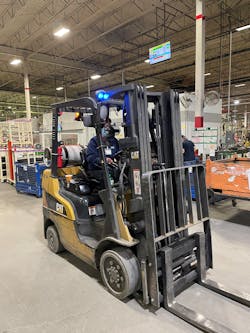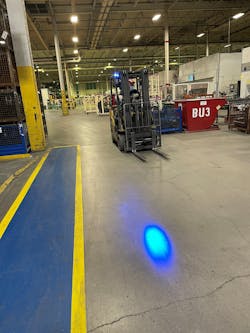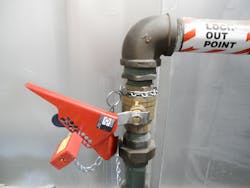Consultants stress importance of risk assessment, standards
By Bruce Geiselman
Plastics processors wanting to improve the health and safety of workers should start by identifying the hazards in their work environment, said Bruce Main, president of Design Safety Engineering, an Ann Arbor, Mich.-based company offering risk-assessment consulting and training services.
The first step is conducting a risk assessment, during which an employer needs to examine the work environment and identify potential sources of harm.
“Basically, when you look at your plant, you want to say, ‘Well, what do my people need to do and where are the potential hazards where they could get hurt?’ ” Main said. “That starts you on the risk-assessment process. Once you’ve identified the hazards, then processors need to look at a variety of risk-reduction measures that are appropriate.”
Sometimes, processors can find published standards that apply, and at other times, they need to use common sense to determine the best feasible risk reduction measure.
While risks will vary from plant to plant, there are some common concerns for plastics processors.
“When you’ve got heated plastics, you’ve got hot surfaces,” Main said. “You’ve got slip and fall [hazards], if some of the material gets on the floor. Dusts are concerns. Often there are traffic hazards.”
Storing and moving materials could be a major concern. Processors need to store and move containers of plastic pellets, deciding where to store them and how they will be fed into processing equipment.
“So, you get material-handling issues, and that gets you into fork-truck traffic typically, unless you have a pneumatic conveying system,” he said.
Protecting workers could involve marking pedestrian walkways or using a physical barrier to separate people from forklift traffic. Convex mirrors that help workers see around corners could be appropriate. Safety education for forklift drivers and pedestrians, along with high-visibility safety vests, also can be key.
Indicators that make workers more aware of forklifts include high-intensity blue LED lights.
“Even if your attention is focused on whatever task you’re doing around the machine, you can catch a glimpse of this LED in your peripheral vision so that you’re aware there’s a fork truck there,” Sberna said. “Plants are noisy so you can’t always hear the fork trucks moving.”
Another common concern is the hazardous energy that can be released while conducting maintenance activities. As an example, injection molding machines can crush maintenance workers who are working in the mold clamping area. Processors need to ensure equipment and workers comply with OSHA requirements for lockout/tagout safety procedures during maintenance work to ensure the equipment will not unexpectedly start or move while workers are in an area where they could be injured.
“It’s the control of hazardous energy,” Main said. “Under OSHA requirements, if you’re doing service or maintenance, you’re expected to lock out the equipment, meaning there’s going to be no unexpected release or startup of the machinery. It could even be the result of gravity. You could have a [mold] fall if you’re in a vertical injection molding machine and hanging out a [mold]. You’ve got to be concerned about that.”
“In the injection molding industry, it is difficult to follow a full OSHA lockout,” Sberna said. “What they would like to do is to be able to follow an alternative method to lockout, but, unfortunately, much of their equipment is not set up to do that.”
For example, most injection molding machines manufactured within the past 3-4 years have safety control circuits designed with redundancy that can prevent machine parts from moving during service or repair. However, older machines typically don’t come with those safety control circuits, and, often, plastics processors don’t understand how to use them to protect workers.
“This is a really big obstacle for these end users to overcome,” Sberna said. “It’s very difficult for them to sort through the nuances of evaluating equipment, preparing proper documentation and making sure the machines are set up to do that. They don’t have the internal resources that have time and the understanding on how to do this.”
However, a lot of companies aren’t aware of the alternatives available to a lock-out procedure or need assistance in determining whether a control circuit they installed on an injection molding machine meets OSHA standards.
White Horse Safety trains plastics processors on the alternative methods for controlling hazardous energy and can review designs for or test systems, such as control circuits, in the plant to be sure they work properly, Sberna said.
Consultants like Main can help companies identify risks, determine OSHA compliance and figure out ways to keep workers safe. Design Safety Engineering also assists companies designing new plants or adding to plants. It can help evaluate the safety of a new plant or plastics processing system before it is installed.
“We’re working with companies on 3-D models to do the evaluation before they actually start building things,” Main said.
Main recommends plastics processors looking to devise a health and safety plan become familiar with the latest ANSI/PLASTICS B151 series of safety standards.
“That’s the codification of best practices by industry experts,” Main said. “Some of those are written for the machine design, but there are also requirements for the users of the machine, and those standards help a great deal to get you going on what’s required and what you can do. The B151 series of standards is a very good place to go. Often, when we get involved, it’s answering specific questions about, ‘Well, how do we apply this? How do we meet this requirement?’ ”
Indoor air quality and adequate ventilation also are potential issues.
“It depends on how much [plastics processing] you are doing,” Main said. “If you’re in a high[-volume] processing facility where you’re doing lots of it with lots of machines, then, absolutely.”
Companies that have only a few machines or process only small volumes of plastic might get data indicating fumes or off-gassing from melting plastics are not hazardous. However, even if off-gassing doesn’t pose a direct health risk, many employers choose to install vents over extruders or take other measures to improve ventilation.
“Maybe it doesn’t reach a level that would require ventilation, but you might decide that to make a safe and healthful workplace, or to enable your employees to work faster and safer and more comfortably, it is worthwhile,” Main said.
Using robots and automation to perform some of the more dull, dirty and dangerous jobs also could result in a safer work environment, Main said.
“If you can replace those jobs with robots, then you’re making a better workplace or a safer workplace,” Main said.
However, while automation has the potential to improve safety, introducing a robot can also increase hazards if you don’t do it correctly, Main cautioned. He said he knew of a young man who was killed because the robot system was not implemented correctly.
“They didn’t know what they didn’t know, or pretended not to know what they didn’t know, and put this young man to work on a robot cell without adequate training and without adequate safeguards,” Main said. “They didn’t have interlocked safety gates.”
Something went wrong with the process, the young man walked into the cell to try to diagnose the problem, and the robot crushed him, Main said.
As with any machine, a robot correctly integrated into a work environment can prevent potential strains and sprains and back injuries from lifting, but an incorrectly integrated robot could kill someone, he said.
In addition, plastics processors need to ensure workers understand appropriate safeguards.
“In most instances that I have seen with automation where people have gotten hurt, it’s not because the automation failed — it’s because the systems were bypassed,” Main said.
Slip-and-fall injuries are another concern in plastics processing facilities, and often they are caused by leaking hydraulic fluid.
“Hydraulic systems obviously leak for various reasons at various times,” Sberna said. “The best way to keep up with your machines and keep them in a nonleaking condition is to make sure they [maintenance workers] replace hoses with the same rated hose and they use fittings that are rated for the pressures as the hose types that are there and that they not just repair hose leaks with any old fitting that you might have on the spare-parts shelf.”
Bruce Geiselman, senior staff reporter
Contact:
Design Safety Engineering Inc., Ann Arbor, Mich., 888-628-8788, www.designsafe.com
White Horse Safety Inc., Georgetown, Ky., 859-333-5875, https://whitehorsesafety.com
About the Author
Bruce Geiselman
Senior Staff Reporter Bruce Geiselman covers extrusion, blow molding, additive manufacturing, automation and end markets including automotive and packaging. He also writes features, including In Other Words and Problem Solved, for Plastics Machinery & Manufacturing, Plastics Recycling and The Journal of Blow Molding. He has extensive experience in daily and magazine journalism.


